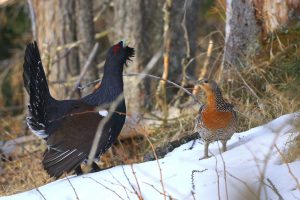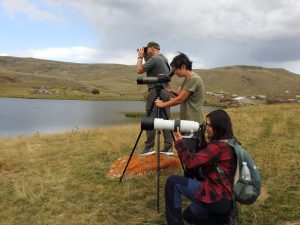
Three bird monitoring projects need your support
September 19, 2024 | alena.klvanova
The European Bird Census Council has set up a Small Grant Fund (SGF) to support national bird monitoring activities, particularly in Europe’s low- and middle-income countries. In 2024, the EBCC Board selected three projects as priorities for support. The projects come from three countries and request nearly 30,000 euros in total. As the EBCC’s resources are insufficient to fund all projects selected for support, we kindly ask individuals or organisations to donate and help us support the projects.
Here, we describe the projects selected for support (the order doesn’t reflect the scores received by each project in the EBCC Board’s evaluation).
SLOVAKIA
Title of the project: Increasing the Quality of Bird Monitoring in Slovakia and Ensuring its Long-term Sustainability.

Mountains in Slovakia, such as the High Tatra, are home to many mountain and boreal species that survive in isolated populations in Central Europe. Photo by Karol Kaliský
This project aims to enhance bird monitoring in Slovakia by improving data quality and supporting long-term efforts to conserve bird populations. Focusing on continuing the national common bird monitoring scheme, developing a new national bird atlas, and expanding the network of fieldworkers, this initiative addresses critical gaps in bird conservation data and coordination.
Key objectives:
- Sustain national breeding bird survey: Continue the national common bird monitoring scheme under the Pan-European Common Bird Monitoring Scheme (PECBMS) framework during a critical transition period involving changes in census methodology and a shift in national authorities’ approach toward monitoring support.
- Prepare the national breeding bird atlas: support the production of a new national bird atlas for Slovakia, focusing on enhancing data quality and integrating advanced modelling techniques to produce occurrence probability maps.
- Strengthen the network of fieldworkers: expand and reinforce the network of volunteer fieldworkers crucial for data collection, ensuring consistent and reliable monitoring coverage across Slovakia.
Planned Activities:
Continuation of the Enhanced Bird Monitoring Scheme: Since 2005, Slovakia has monitored bird populations using a point count method. In 2023, a new stratified random site selection method was introduced to improve data quality, but financial support for coordination was abruptly halted due to government changes. Despite this, volunteer fieldworkers and coordinators ensured data collection at 100 sites in 2024. The project aims to maintain and potentially expand coverage to over 100 sites in 2025 by actively recruiting new fieldworkers and updating necessary tools, including a mobile application for data collection.
Develop the new national bird atlas: Following 10 years of extensive fieldwork across 564 grid squares, Slovakia’s new distribution bird atlas is set to surpass its 2002 predecessor by including advanced modelled maps of bird species’ occurrence probabilities. However, this requires specialised expertise, which is currently lacking due to reduced support from national authorities. This project will provide the necessary resources to produce at least 80 modelled maps, enabling the completion of species-specific texts and other critical atlas components.

Slovakia’s highest mountains belong to the last regions where populations of Capercaillie survive. Photo by Karol Kaliský
Expected Outcomes:
- Monitoring coverage at over 100 sites across Slovakia in 2025.
- Development of at least 80 modelled maps predicting bird species occurrence for the new national bird atlas.
Ján Svetlík and Soňa Svetlíková, Breeding Bird Survey coordinators in Slovakia, say: ´Thanks to the grant support, we would like to improve the overall interest in environmental awareness through birds, despite our country’s shallow interest in nature conservation. We think it is surprisingly one of the most difficult tasks in a country that has been part of the European Union for a long time and still suffers from a lack of interest in the long-term use of the environment for all of us.’
Jozef Ridzoň, the coordinator of national atlas work, adds: ´Thanks to the grant support, we will be able to improve the quality of the new national atlas scheduled for publishing hopefully by 2026 thanks to the producing of modelled new probability occurrence map, which was not published until now in Slovakia. Such support is, however, not possible from national resources due to the general threat to civil society and NGOs in Slovakia despite being part of the EU. Therefore, the grant will help bridge a complicated period, which is crucial for the continuation of work on the atlas, which is heading to the final stages.´
SERBIA
Title of the project: National Breeding Bird Atlas of Serbia – a survey of rare forest birds and first Census of Collared Sand Martin colonies.

Serbian natural forests in Rogozna mountains, where the rare forest birds will be surveyed. Photo by Marko Šćiban
This project aims to fill critical knowledge gaps about Serbia’s rare breeding forest birds and Collared Sand Martin colonies, contributing to the development of Serbia’s first national atlas of breeding birds. This project will provide crucial data for bird conservation efforts and the protection of Serbia’s natural heritage by conducting comprehensive surveys in poorly studied regions, training volunteers, and engaging local communities.
Key Objectives:
- Survey rare forest birds: Conduct surveys in natural forests across southern, eastern, and western Serbia to map the distribution of poorly known breeding forest bird species (Ficedula albicollis, Ficedula semitorquata, Ficedula parva, Phylloscopus trochilus, Phylloscopus orientalis, Phylloscopus sibilatrix). These surveys will help clarify species distribution and identify conservation needs.
- First national census of Collared Sand Martin colonies: Complete a comprehensive census of all active Collared Sand Martin (Riparia riparia) colonies in Serbia, using systematic mapping and field surveys to provide a clear picture of the species’ current status and address the sharp population decline in recent decades.
- Support the first atlas of breeding birds of Serbia (ABBS): Collect and analyse new data for the national bird atlas, filling gaps in current knowledge and enabling better conservation planning for Serbia’s avifauna.
Planned Activities:
Forest bird surveys: Organize surveys in 14 under-researched mountains of southern Serbia, performing over 140 point counts in suitable forest habitats. Fieldwork will occur from late April to early June 2025, with trained fieldworkers collecting data. The findings will help model the current distribution of six rare forest bird species and contribute to a scientific paper on their status.
Collared Sand Martin census: Starting in April 2025, conduct a thorough GAP analysis of historical data from the BPSSS database to plan targeted fieldwork. During May, June, and July 2025, visit known and new Collared Sand Martin colonies across Serbia, including challenging regions like central Serbia and the riverbanks of the Danube, Drina, Tisa, and Morava. This activity will involve counting nesting holes and ringing birds to track movements.
Training and community involvement: Train at least 50 fieldworkers through workshops, field exercises, and digital tools, ensuring high-quality data collection and broader public engagement in bird conservation efforts. The involvement of trained volunteers is expected to enhance the detection of key Flycatcher and Warbler species beyond the planned survey areas.

Fieldworkers during the surveys, with Marko Šćiban, the project coordinator, in the front. Photo by Marko Šćiban
Expected Outcomes:
- Completion of at least 140 point counts for rare forest bird species.
- First comprehensive census of at least 110 Collared Sand Martin colonies in Serbia.
- Collection of at least 10,000 georeferenced data points for the ABBS.
- Training and inclusion of over 50 field assistants in project activities.
Marko Šćiban, the project coordinator, says: ‘This project is separated into two distinct activities. The first one is important for us because it will help us organise the first national count of Sand Martins in Serbia, which currently has one of the worst population declines in Europe, especially in Eastern Europe. This trend was already recorded in previous years, but now we want to check how many Sand Martins currently live in the country and how we could monitor the trend of their population in the future. The second activity is a survey of 14 forests of mountains in southern and central Serbia in search of rare flycatcher and warbler species whose edges of distribution are situated in the Balkan Peninsula, some of them northern, some of them southern. Due to intensive forest cutting, the semicollared, Collared and Red-breasted Flycatchers are confined to increasingly disappearing old forests. Wood, Eastern Bonelli’s, and Willow Warblers are also confined to specific mountain forest types. Both activities will help us fill the gaps in the work on the first national Atlas of breeding birds of Serbia and increase the overall knowledge of the edges of distribution for these easily overlooked species.’
ARMENIA
Title of the project: Breeding Bird Atlas of Armenia – Publishing the first atlas and building capacity for future monitoring.

Armenian Field Crew, no bird can avoid being counted. Photo by BirdLinks Armenia
This project, led by NGO BirdLinks Armenia, aims to publish the first-ever Breeding bird atlas of Armenia and strengthen the capacity to ensure long-term bird monitoring. The atlas will serve as a comprehensive resource for conservation planning, while training and involving local volunteers will enhance the sustainability of future monitoring efforts.
Key Objectives:
- Publish the first Breeding bird atlas of Armenia: develop and publish a detailed atlas that provides vital information on Armenia’s 242 breeding bird species. This will include species distribution maps, population trends, conservation status, and threats, providing a crucial tool for researchers, policymakers, and conservationists.
- Strengthen volunteer capacity for bird monitoring: enhance the skills and engagement of the fieldworkers, who play a critical role in data collection, through improved training programs and involvement in future monitoring efforts.
Planned Activities:
Statistical and spatial analysis: perform comprehensive analyses to determine the population size, trends, distribution, and conservation status of 242 bird species. This includes developing maps and calculating key metrics like area of occupancy and extent of occurrence.
Threat assessment: Evaluate threats to each species using the IUCN threat classification scheme, prioritise these threats, and analyse species sensitivity.
Atlas compilation and publishing: write and finalise the Atlas, covering methodology, species accounts, and conservation implications. The Atlas will be printed and presented at a national event, where a Memorandum of Understanding (MoU) with the Ministry of Environment for a ten-year update cycle will be signed.
Training and capacity building: Revise bird identification and data collection training programs. Conduct training sessions for 20 new volunteers participating in the next breeding bird monitoring season to ensure high-quality data collection.
Expected outputs:
- Publication of the first Breeding Bird Atlas of Armenia, with at least 200 copies distributed.
- Signing of an MoU with the Ministry of Environment for a ten-year update cycle of the Atlas.
- Training at least 20 volunteers in bird identification and data collection, enhancing the society’s long-term monitoring capacity.
Karen Aghababyan, project coordinator, says: ‚ The Armenian National Bird Monitoring is a powerful tool for influencing decision-making on species, area use, and policy. One of the planned outcomes is the Atlas on Breeding Birds of Armenia, which will be the first-ever publication to update the state of the birds in the country.‘
We would appreciate donations of any amount sent to the EBCC account (see below). Thank you!
We will inform the donors and broader audience about the projects via the EBCC Newsletter and website.
Contact
Petr Voříšek, vorisek@ebcc.info
EBCC Officer
EBCC Bank Account
Name of account holder: EBCC treasurer
Address bank: ING Bank NV POB 1800 1102 BW Amsterdam Netherlands
IBAN (International Bank Account Number): NL62INGB0004235670
BIC (SWIFT-code): INGBNL2A
EBCC is an association under Dutch law.